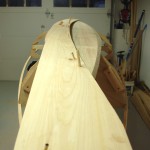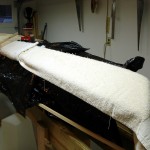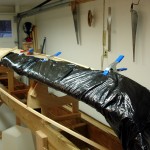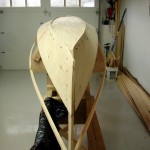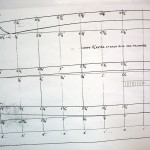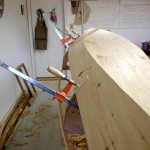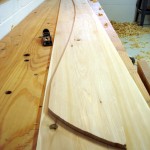#$%*&!!! DANG!
I don’t have the 7/8″ cut copper tacks (also called clinch nails) needed to attach the garboard planks. I ordered all of the fasteners some months ago, but had forgotten that this particular size of tacks were out of stock. Apparently, they are a scarce size. Three of four providers still list them as out of stock. The fourth has a minimum order quantity of 50 pounds, which is 49 and 1/2 pounds more that this boat needs. A couple hours searching found a roof gutter firm in Pennsylvania that has them in reasonable quantities. They’ll be here in a few days.
ADVICE: If you think you have everything you need for your current project, stop right now and go double check.
Clinch nailing is not very common these days, and I have never done it. I watched some other guys do it at the Wooden Boat School, but didn’t get into it myself. So, it was time for some practice on scrap lumber. The concept is simple. Use a nail that is a bit longer than the pieces of wood being joined. Cause the tip of the nail to turn and bury itself inside the wood. I imagine many of us have had experience with the tenacity of unintentionally bent fasteners. They don’t come out easily. I’m guessing that some ancient bent nail victim said, “Hey, I have an idea…” and came up with the idea of clinching. The result is indeed tenacious.
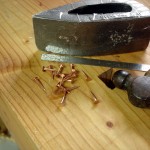 Boat builders use copper tacks in pre-drilled holes, a lightweight hammer, and a clinching iron. The iron has enough mass to do the job, and is interestingly curved to get right up close to a boat’s many non-flat surfaces. The process is simple. Place the iron at the spot where the tip of the nail should emerge and then hammer the nail in place. The tip hits the iron and goes back into the wood. Watch this video of Brahm and his friend doing clinch nailing at Hillmark Boats. It is as simple as it looks.
Boat builders use copper tacks in pre-drilled holes, a lightweight hammer, and a clinching iron. The iron has enough mass to do the job, and is interestingly curved to get right up close to a boat’s many non-flat surfaces. The process is simple. Place the iron at the spot where the tip of the nail should emerge and then hammer the nail in place. The tip hits the iron and goes back into the wood. Watch this video of Brahm and his friend doing clinch nailing at Hillmark Boats. It is as simple as it looks.
Before you ask why my clinching iron looks like it’s wrapped in packing tape, I’ll answer. Yes, it is. Mine is iron and will leave dark marks. The tape helps avoid the unsightly marks. The other alternative is a bronze clinching iron. The price difference between iron and bronze will by a couple of cases of Snickers bars.
As always, click on any image to see a larger version.
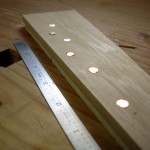
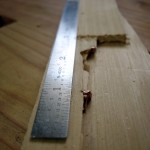 Now, I’m curious about how well the joint holds and what the nails look like (inside the wood) when clinched. So here are a couple of destructive tests. One is joining a 5/16 inch thick board with a much thinner piece. I used 3/4 inch tacks, which I obviously have, and found that a curl of almost 360 degrees is formed inside the wood. It took a good bit of effort to pry the boards apart and the curled ends of some nails refused to release the fibers they had trapped. Yet, I think this is less than optimal because the curl traps too little material.
Now, I’m curious about how well the joint holds and what the nails look like (inside the wood) when clinched. So here are a couple of destructive tests. One is joining a 5/16 inch thick board with a much thinner piece. I used 3/4 inch tacks, which I obviously have, and found that a curl of almost 360 degrees is formed inside the wood. It took a good bit of effort to pry the boards apart and the curled ends of some nails refused to release the fibers they had trapped. Yet, I think this is less than optimal because the curl traps too little material.
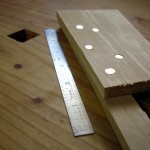
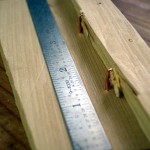 The other test is again using 3/4 inch tacks, but this time joining two 5/16 inch boards. This time the end of the tack made a 180 degree turn, but no more. It trapped more fibers. This joint was very difficult to break, and is much more tenacious than the one with the full curl.
The other test is again using 3/4 inch tacks, but this time joining two 5/16 inch boards. This time the end of the tack made a 180 degree turn, but no more. It trapped more fibers. This joint was very difficult to break, and is much more tenacious than the one with the full curl.
These tests show how the length of the nails, in porportion to the wood being joined, is important. Too short, no clinching. (You don’t get to see that test.) Too long, we get a circular curl. Just right, a 180 degree turn and a strong clinch. Seeing these results, I’ll believe the designer’s specs and wait for the rare 7/8 inch tacks.
